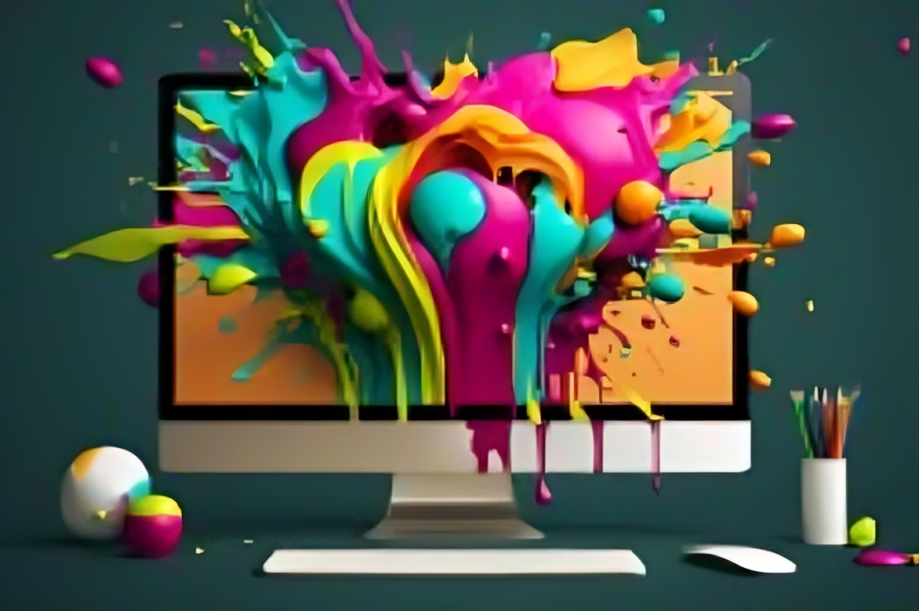A Comprehensive Guide to Graphic Design for Beginners
by Admin · Published · Updated

Graphic design for beginners can feel like a daunting journey, but with the right guidance and resources, anyone can navigate this vibrant field. Whether you aim to create stunning visuals for personal projects or pursue a career as a motion graphics designer, understanding the basics of graphic design is crucial. In this guide, we’ll explore fundamental concepts, essential tools, and tips for budding graphic designers.
Understanding Graphic Design
At its essence, graphic design is the art of visual communication.. It combines images, text, and colors to convey messages and ideas effectively. For beginners, it’s essential to grasp the key principles of design, including balance, contrast, hierarchy, and alignment. These principles serve as the foundation upon which all successful designs are built.
Key Principles of Graphic Design
- Balance: This principle involves distributing visual elements evenly within a design. Balance can be symmetrical (where elements are evenly placed) or asymmetrical (where elements differ but still feel balanced).
- Contrast: Contrast helps elements stand out by using differences in color, size, shape, or texture. It’s essential for creating focal points and improving readability.
- Hierarchy: This principle guides the viewer’s eye through a design, establishing a visual order of importance. By varying font sizes and weights or using different colors, you can lead viewers to the most critical information.
- Alignment: Proper alignment ensures that elements are organized and related to each other, enhancing the overall structure and coherence of the design.
- Repetition: Repeating certain elements creates consistency and reinforces your design’s theme. This could include colors, fonts, or shapes.

Essential Tools for Graphic Design
For beginners, familiarizing yourself with the right tools can significantly enhance your design skills. Here are some popular software options:
- Adobe Photoshop: Widely regarded as the industry standard for photo editing and graphic design, Photoshop is essential for creating and manipulating images.
- Adobe Illustrator: This vector graphics editor is perfect for creating logos, icons, and illustrations. Its scalability makes it a favorite among graphic designers.
- Canva: A user-friendly tool for beginners, Canva offers a plethora of templates and design elements that allow you to create professional-looking designs without extensive knowledge of graphic design software.
- Inkscape: As a free alternative to Illustrator, Inkscape provides many powerful vector graphic tools that are ideal for beginners who want to explore graphic design without a financial commitment.
- Figma: This collaborative interface design tool is gaining popularity, especially among web and app designers.It’s ideal for working on prototypes and wireframes.
Starting Your Journey: Learning Resources
As a beginner in graphic design, you have access to a wealth of learning resources.The following are some suggested paths to pursue:
- Online Courses: Websites like Udemy, Skillshare, and Coursera offer various courses tailored for beginners. These courses cover everything from the basics of graphic design to more specialized areas like motion graphics.
- YouTube Tutorials: YouTube is a treasure trove of tutorials for graphic design. Channels dedicated to design principles, software tips, and project walkthroughs can be invaluable for beginners.
- Books: Consider reading books such as “The Non-Designer’s Design Book” by Robin Williams, which simplifies design concepts for beginners. Another great read is “Graphic Design: The New Basics” by Ellen Lupton and Jennifer Cole Phillips.
- Design Communities: Join online forums or social media groups focused on graphic design. These communities can provide feedback, inspiration, and support as you develop your skills.
Exploring Motion Graphics
As you become more comfortable with graphic design for beginners, you might consider expanding your skills into motion graphics. A motion graphics designer focuses on creating animated visuals that can enhance storytelling in videos, advertisements, and digital content. Motion graphics combine graphic design principles with animation techniques, making it a dynamic and exciting field.
Skills Required for Motion Graphics Design
To become a successful motion graphics designer, you should develop specific skills:
- Animation Principles: Understanding the fundamentals of animation—such as timing, easing, and keyframes—is crucial for creating fluid, engaging motion graphics.
- Software Proficiency: Familiarity with software like Adobe After Effects, Blender, or Cinema 4D is essential for creating and editing motion graphics.
- Storytelling: A good motion graphics designer knows how to convey a narrative through visual elements. This includes pacing, visual rhythm, and the effective use of sound.
- Attention to Detail: Precision is vital in motion graphics, from the timing of animations to the synchronization of sound effects.
Building Your Portfolio
As you gain experience in graphic design for beginners and motion graphics, it’s crucial to create a portfolio showcasing your work. Your portfolio should highlight a range of projects that demonstrate your skills and creativity.The following advice can help you create a strong portfolio::
- Diverse Projects: Include various types of work—logos, posters, animations, and any personal projects. This diversity will showcase your versatility as a designer.
- Process Over Product: Don’t just display finished pieces; include sketches, drafts, and explanations of your design process. This will demonstrate your problem-solving skills to prospective customers or employers.
- Online Presence: Consider creating a personal website or using platforms like Behance or Dribbble to showcase your work.In the current digital era, an online portfolio is indispensable.
- Seek Feedback: Share your portfolio with peers and mentors for constructive criticism. This can help you identify areas for improvement and refine your work.
Graphic design for beginners is an exciting field filled with endless possibilities. By understanding fundamental design principles, mastering essential tools, and exploring areas like motion graphics, you can develop your skills and carve a niche for yourself in the design world. Remember, practice is key; the more you experiment and create, the more proficient you will become.
As you embark on your journey, keep an open mind and be willing to learn from both successes and challenges. Whether you aim to become a motion graphics designer or explore other avenues in graphic design, your creativity and determination will be your greatest assets. Embrace the process, and soon you’ll find yourself creating captivating designs that speak to audiences far and wide.



